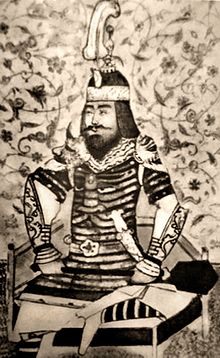帖木兒
帖木兒(波斯-阿拉伯文:تیمور,拉丁轉寫:Tēmōr,為察合臺話鐵之意;英文Timur,又Tamerlane,1336年—1405年)係帖木兒汗國開國大汗。佢以武力承繼察合臺汗國。學成吉思汗征服四方。其後人建立蒙兀兒汗國。雖然佢承繼蒙古人汗國,但史學家認爲佢係突厥人。帖木兒史料,多數來自家傳自傳,。

生喺1320年代嘅蒙古同突厥化嘅巴魯拉斯聯盟入面,喺而家嘅烏茲別克斯坦嘅中亞河中,帖木兒喺1370年控制咗西察合台汗國。從呢個根據地出發,佢喺西亞、南亞、中亞、高加索同南俄羅斯領導軍事遠征,打敗咗金帳汗國嘅汗、埃及同敘利亞嘅馬木魯克蘇丹國、新興嘅奧斯曼帝國,以及印度嘅德里蘇丹國,成為咗穆斯林世界最有權力嘅統治者。[1]喺呢啲征服之後,佢建立咗帖木兒帝國,但係喺佢死後唔耐就瓦解咗。佢識得講幾種語言,包括察合台語(而家烏茲別克語嘅祖先)、蒙古語同波斯語,佢用呢啲語言寫外交信件。
帖木兒係歐亞大草原最後一個偉大嘅遊牧征服者,佢嘅帝國為16同17世紀更有組織同持久嘅伊斯蘭火藥帝國嘅崛起奠定咗基礎。[2][3][4] 帖木兒係突厥同蒙古人嘅後裔,雖然佢可能唔係成吉思汗嘅直系後裔,但係喺佢父親嗰邊同成吉思汗有共同祖先,[5][6][7] 不過有啲作者認為佢嘅母親可能係成吉思汗嘅後裔。[8][9] 佢喺生前明顯想喚起成吉思汗征服嘅遺產。[10] 帖木兒想恢復蒙古帝國,根據傑拉爾·沙利安嘅講法,佢睇自己係成吉思汗嘅繼承人。[11]
早年生平
編輯帝汶出世喺恰加台汗國嘅特蘭索克西亞那,喺開什城(依家嘅烏茲別克沙赫里薩布茲)附近,大約喺撒馬爾罕以南80公里(50英里)嘅地方。[12] 佢個名「帝汶」喺佢嘅母語恰加台語入面係解「鐵」(cf. 烏茲別克語嘅「Temir」,土耳其語嘅「Demir」)。[13] 呢個名同成吉思汗個出世名「鐵木真」係同源嘅。[14][15] 後來嘅帝汶王朝歷史話帝汶係喺1336年4月8日出世,但係大多數同期嘅資料都顯示佢可能係喺1320年代後期出世。歷史學家比阿特麗斯·福布斯·曼茲懷疑1336年呢個日期係為咗將帝汶同伊兒汗國最後一位統治者阿布·賽義德·巴哈杜爾汗嘅遺產聯繫起來,因為後者就係喺嗰年死嘅。[16]
佢係巴爾拉斯族嘅一員,呢個係一個已經喺好多方面突厥化嘅蒙古部族。[17][18][19][20][21][22][23] 佢老豆塔拉蓋被形容為呢個部族嘅一個小貴族。[12] 不過,曼茲認為帝汶可能後來低估咗佢老豆嘅社會地位,為咗令佢自己嘅成就睇起嚟更加出色。佢話雖然唔相信塔拉蓋特別有權勢,但佢都算係幾富有同有影響力嘅。[16]:116 呢一點喺《札法爾納瑪》入面都有提到,話帝汶喺1360年佢老豆死後返去佢出世嘅地方,顯示佢關心佢老豆嘅遺產。[24] 塔拉蓋嘅社會地位喺阿拉伯沙赫嘅描述入面都有暗示,佢形容塔拉蓋係卡拉烏納斯嘅阿米爾侯賽因宮廷入面嘅一個大臣。[9] 另外,莫臥兒汗國嘅大阿米爾哈米德·克雷伊德嘅老豆都話係塔拉蓋嘅朋友。[25]
喺佢細個嗰陣,帝汶同一班細隊友搶劫旅客嘅財物,特別係羊、馬同牛咁嘅動物。[16]:116 大約喺1363年,有人相信帝汶想偷一隻羊,但係俾人射咗兩箭,一箭射中佢右腳,另一箭射中佢右手,仲斷咗兩隻手指。呢兩次受傷令佢終身殘疾。有啲人相信呢啲傷係喺佢做傭兵幫錫斯坦嘅汗打仗嗰陣發生嘅,地點就係今日阿富汗西南部嘅達什提馬爾戈。帝汶嘅傷同殘疾令佢有咗個花名叫「跛腳帝汶」,喺波斯語入面叫做「Temūr(-i) Lang」,呢個就係西方叫佢「帖木兒」(Tamerlane)嘅由來。[26]
軍事領袖
編輯Template:Timur's conquests 到咗大約1360年,帝汶已經成為一個軍事領袖,佢手下大多數係嗰個地區嘅突厥部落成員。[11] 佢同恰加台汗國嘅汗一齊參與咗特蘭索克西亞那嘅戰役。佢同推翻同摧毀伏爾加保加利亞嘅卡札干結盟,仲成為咗親家,之後佢率領一千騎兵入侵咗大呼羅珊。[27] 呢個係佢帶領嘅第二次軍事遠征,成功咗之後就帶起更多行動,包括征服花剌子模同烏爾根奇。[28]
卡札干俾人謀殺之後,好多人都想爭奪統治權力。東恰加台汗國嘅汗、喀什噶爾嘅脫古魯帖木兒,一個成吉思汗嘅後代,趁住呢個混亂入侵。帝汶被派去同入侵者談判,但係佢反而加入咗對方,仲俾咗特蘭索克西亞那嚟獎勵佢。大約喺呢個時候,佢老豆過身,帝汶都成為咗巴爾拉斯族嘅首領。脫古魯之後想派佢個仔伊利亞斯豁者管理特蘭索克西亞那,但係帝汶用一支小部隊就擊退咗呢次入侵。[27]
崛起
編輯喺呢段時期,帝汶將恰加台汗國嘅汗貶為傀儡,而佢就以汗嘅名義統治。同時,帝汶同佢妹夫阿米爾·侯賽因,原本係一齊逃亡同流浪嘅,變成咗對手同敵人。[28] 佢哋關係變差係因為侯賽因放棄咗執行帝汶嘅命令,冇喺塔什干附近解決伊利亞斯·豁者(前馬瓦蘭納赫爾總督)。[29]
帝汶喺巴爾赫得到咗好多追隨者,包括商人、同族人、伊斯蘭教僧侶、貴族同農民,因為佢慷慨分享自己嘅財產俾佢哋。呢個同侯賽因嘅行為形成鮮明對比,侯賽因疏遠咗呢啲人,用重稅搶走佢哋好多財產,仲自私咁用稅收起豪華建築。[30] 大約喺1370年,侯賽因向帝汶投降,之後俾人刺殺,令帝汶可以喺巴爾赫正式宣布成為統治者。佢娶咗侯賽因嘅老婆薩萊·穆爾克·哈通,一個成吉思汗嘅後代,令佢可以成為恰加台部族嘅帝國統治者。[31]
疏仕
編輯- ↑ Shahane, Girish (28 December 2016). "Counterview: Taimur's actions were uniquely horrific in Indian history". Scroll.in.
- ↑ Darwin, John (2008). After Tamerlane: the rise and fall of global empires, 1400–2000. Bloomsbury Press. pp. 29, 92. ISBN 978-1596917606.
- ↑ Manz 1999, p. 1.
- ↑ Marozzi, Justin (2006). Tamerlane: Sword of Islam, Conqueror of the World. Da Capo Press. p. 342. ISBN 978-0306814655.
- ↑ Donald M. Seekins; Richard F. Nyrop (1986). Afghanistan A Country Study (English). The Studies. p. 11. ISBN 978-0160239298 –透過Google Books.
Timur was of both Turkish and Mongol descent and claimed Genghis Khan as an ancestor
{{cite book}}: CS1 maint: unrecognized language (link) - ↑ International Association for Mongol Studies (2002). Монгол Улсын Ерөнхийлөгч Н. Багабандийн ивээлд болж буй Олон Улсын Монголч Эрдэмтний VIII их хурал (Улаанбаатар хот 2002.VIII.5-11): Илтгэлүүдийн товчлол [Eighth International Congress of Mongolists being convened under the patronage of N. Bagabandi, president of Mongolia (Ulaanbaatar city 2002.VIII.5-11): Summary of presentations] (Mongolian). OUMSKh-ny Nariĭn bichgiĭn darga naryn gazar. p. 377 –透過Google Books.
First of all, Timur's genealogy gives him a common ancestor with Chinggis Khan in Tumbinai – sechen or Tumanay Khan
{{cite book}}: CS1 maint: unrecognized language (link) - ↑ 引用錯誤 無效嘅
<ref>標籤;無文字提供畀叫做woods嘅參照 - ↑ Henry Cabot Lodge (1916). The History of Nations (English).第14卷. P. F. Collier & son. p. 46.
Timur the Lame, from the effects of an early wound, a name which some European writers have converted into Tamerlane, or Tamberlaine. He was of Mongol origin, and a direct descendant, by the mother's side, of Genghis Khan
{{cite book}}: CS1 maint: unrecognized language (link) - ↑ 9.0 9.1 引用錯誤 無效嘅
<ref>標籤;無文字提供畀叫做Arabshah2017嘅參照 - ↑ Richard C. Martin, Encyclopedia of Islam and the Muslim World A–L, Macmillan Reference, 2004, ISBN 978-0028656045, p. 134.
- ↑ 11.0 11.1 Gérard Chaliand, Nomadic Empires: From Mongolia to the Danube translated by A.M. Berrett, Transaction Publishers, 2004. translated by A.M. Berrett. Transaction Publishers, p. 75. ISBN 076580204X. Limited preview於Google Books。. p. 75., ISBN 076580204X, p. 75., "Timur Leng (Tamerlane) Timur, known as the lame (1336–1405) was a Muslim Turk. He aspired to recreate the empire of his ancestors. He was a military genius who loved to play chess in his spare time to improve his military tactics and skill. And although he wielded absolute power, he never called himself more than an emir.", "Timur Leng (Tamerlane) Timur, known as the lame (1336–1405) was a Muslim Turk from the Umus of Chagatai who saw himself as Genghis Khan's heir."
- ↑ 12.0 12.1 "Tamerlane". AsianHistory. 原著喺5 October 2011歸檔. 喺1 November 2013搵到.
- ↑ Richard Peters, The Story of the Turks: From Empire to Democracy (1959), p. 24
- ↑ Glassé, Cyril (2001). The new encyclopedia of Islam (第Rev.版). Walnut Creek, CA: AltaMira Press. ISBN 0759101892. OCLC 48553252.
- ↑ Sinor, Denis (1990). "Introduction: The concept of Inner Asia". The Cambridge History of Early Inner Asia. Cambridge University Press. pp. 1–18. doi:10.1017/chol9780521243049.002. ISBN 978-0521243049.
- ↑ 16.0 16.1 16.2 Manz, Beatrice Forbes (1988). "Tamerlane and the Symbolism of Sovereignty". Iranian Studies. 21 (1–2): 105–122. doi:10.1080/00210868808701711. ISSN 0021-0862. JSTOR 4310596.
- ↑ "Central Asia, history of Timur", in Encyclopædia Britannica, Online Edition, 2007. (Quotation:"Under his leadership, Timur united the Mongol tribes located in the basins of the two rivers.")
- ↑ "Islamic world", in Encyclopædia Britannica, Online Edition, 2007. Quotation: "Timur (Tamerlane) was of Mongol descent and he aimed to restore Mongol power."
- ↑ Carter V. Findley, The Turks in World History, Oxford University Press, 2005, ISBN 978-0195177268, p. 101.
- ↑ G. R. Garthwaite, The Persians, Malden, ISBN 978-1557868602, MA: Blackwell Pub., 2007. (p.148) Quotation: "Timur's tribe, the Barlas, had Mongol origins but had become Turkic-speaking ... However, the Barlus tribe is considered one of the original Mongol tribes and there are "Barlus Ovogton" people who belong to Barlus tribe in modern Mongolia."
- ↑ M.S. Asimov & Clifford Edmund Bosworth, History of Civilizations of Central Asia, UNESCO Regional Office, 1998, ISBN 9231034677, p. 320: "One of his followers was [...] Timur of the Barlas tribe. This Mongol tribe had settled [...] in the valley of Kashka Darya, intermingling with the Turkic population, adopting their religion (Islam) and gradually giving up its own nomadic ways, like a number of other Mongol tribes in Transoxania ..."
- ↑ Kravets, S. L.; 等, 編 (2016). "ТИМУ́Р ТАМЕРЛАН" [Timúr Tamerlan]. Great Russian Encyclopedia (俄文).第32: Televizionnaya bashnya - Ulan-Bator卷. Moscow: Great Russian Encyclopedia. ISBN 978-5-85270-369-9. 喺26 October 2023搵到.
Сын бека Тарагая из тюркизированного монг. племени барлас
[Son of Bek Taragai from the Turkified Mongol Barlas tribe] - ↑ "Timur". Encyclopædia Britannica. 5 September 2023. § Life. 喺26 October 2023搵到.
Timur was a member of the Turkicized Barlas tribe, a Mongol subgroup that had settled in Transoxania (now roughly corresponding to Uzbekistan) after taking part in Genghis Khan's son Chagatai's campaigns in that region.
- ↑ Sharaf ad-Din Ali Yazdi, Zafarnama (1424–1428), p. 35
- ↑ Sharaf ad-Din Ali Yazdi, Zafarnama (1424–1428), p. 75
- ↑ Marozzi 2004, p. 31.
- ↑ 27.0 27.1 Ian C. Hannah (1900). A brief history of eastern Asia. T.F. Unwin. p. 92. 喺30 December 2015搵到.
- ↑ 28.0 28.1 Goldsmid 1911, p. 994.
- ↑ Marozzi 2004, p. 40.
- ↑ Marozzi 2004, pp. 41–42.
- ↑ Marozzi 2004, p. [未記頁數].